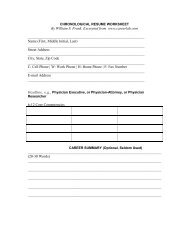Test-Retest Reliability and the Birkman Method - CareerLab
Test-Retest Reliability and the Birkman Method - CareerLab
Test-Retest Reliability and the Birkman Method - CareerLab
You also want an ePaper? Increase the reach of your titles
YUMPU automatically turns print PDFs into web optimized ePapers that Google loves.
second cup of coffee. You might argue that you missed a few questions because you were<br />
not yet awake. Or you could argue <strong>the</strong> opposite, that you had four cups of coffee <strong>and</strong><br />
subsequently had so much caffeine that you could not keep your attention focused. In ei<strong>the</strong>r<br />
case, you might tell yourself that 82 does not accurately measure your knowledge since your<br />
average score in <strong>the</strong> class is a 96. In a word, your individual response has changed due to<br />
an internal change.<br />
Indeed, clients talk about reliability typically only in regards to <strong>the</strong>ir own individual scores.<br />
However, <strong>the</strong> scientific method is applied not to an individual’s score but to a group of scores.<br />
So when instrument reliability is discussed <strong>the</strong> unit of analysis is not <strong>the</strong> individual but a<br />
group. Therefore, an instrument might demonstrate a very high reliability but some individual<br />
scores will vary greatly. One way of thinking about this is that most people would be able to<br />
predict that bubbles would start appearing in a pan (boiling) on a range at 212°F. However, it<br />
is virtually impossible to predict where <strong>and</strong> which individual bubble would be first. While <strong>the</strong>re<br />
are exceptions, science typically measures groups <strong>and</strong> not individuals. In any case, <strong>the</strong><br />
measure of reliability reflects differences averaged across groups. Individual unreliability is<br />
greatly reduced by sampling a group of individuals. We can see <strong>the</strong> application of this<br />
principle by referring to <strong>the</strong> data below selected from Table 1 (see page 3).<br />
Components Usual Need<br />
Esteem 0.81 0.70<br />
The numbers (statistics) for Esteem Usual <strong>and</strong> Need reflect <strong>the</strong> strength of <strong>the</strong> relationship<br />
between responses in <strong>the</strong> first session <strong>and</strong> responses in <strong>the</strong> second session (this statistic is a<br />
correlation <strong>and</strong> is often referred to as <strong>the</strong> coefficient of stability). The important concept here<br />
to underst<strong>and</strong> is that <strong>the</strong>se scores reflect <strong>the</strong> average of <strong>the</strong> products (st<strong>and</strong>ardized) of all 77<br />
people participating in <strong>the</strong> study. Individual differences between <strong>the</strong> two sessions are not



